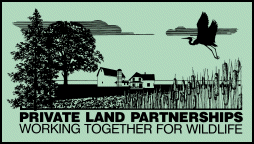 |
|
TREES & SHRUBS
|
Trees and shrubs can help provide a wide variety
of backyard landscape designs
while creating valuable wildlife habitat. Planting trees and shrubs
offers a variety of benefits to your home. They add color to landscapes, provide
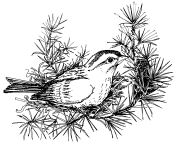 shade in summer, protection from wind in winter, and offer texture to the
area around your home. These plantings reduce the size of your lawn, which saves you time
and money as you will not need as much mowing, fertilizers, or pesticides. They may also increase
the value of your home. shade in summer, protection from wind in winter, and offer texture to the
area around your home. These plantings reduce the size of your lawn, which saves you time
and money as you will not need as much mowing, fertilizers, or pesticides. They may also increase
the value of your home.
The wildlife habitat that trees and shrubs create includes sites for nesting and
rearing young, secure winter cover,
and summer, fall, and winter foods. For example, dense pines and spruces provide roosting
sites and escape cover for mourning doves, chickadees, and other songbirds. Gray dogwood and American
mountain-ash offer fall fruits to migrating birds, and oaks and hickories provide hard
mast (nuts) to squirrels and blue jays in winter and cool shade on hot summer days.
There are four factors to consider when choosing trees and shrubs for your backyard:
(1) your landscaping goals, (2) wildlife values of the trees and shrubs, (3) their aesthetic characteristics (color,
texture, height), and (4) your landscape’s characteristics (soils, slope, location).
Plants that serve multiple purposes, such as providing both food for wildlife and
aesthetic beauty for your home, deserve the strongest consideration.
Landscaping Goals
Before deciding what to plant, you must determine what goals you have for landscaping.
Are you interested in creating a colorful backyard? Do you want to develop visual barriers
from neighbors or sound barriers from a noisy street? Is
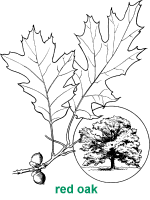 providing shade important? Is your goal to protect your home from winter winds? To help
you determine your goals, refer to the chapter Setting
Goals and Considering Alternatives in the Habitat
Planning section.
providing shade important? Is your goal to protect your home from winter winds? To help
you determine your goals, refer to the chapter Setting
Goals and Considering Alternatives in the Habitat
Planning section.
Oaks, hickories, maples, and other large deciduous trees planted on the south
side of your home can provide relieving shade in summer and allow the winter sun to
furnish warmth. Conifers mixed with
tall and medium shrubs provide a privacy screen. Medium and short shrubs mixed with perennial flowering plants can
furnish color and serve as attractive foundation plantings around the base of your home,
as well as backgrounds to formal flower plantings and borders around trees, fences, and
other structures.
A mixture of deciduous plants (whose leaves drop in fall) and conifers (evergreens) is
highly effective for creating shade, shelterbelts or windbreaks, and visual barriers.
Locate them on the windward side of the area to be protected and plant them a distance
from your home of three to four times the mature height of the tallest plant. In other
words, if the tallest tree in the windbreak is 50 feet, plant the windbreak 150 to 200
feet from your home.
Wildlife Values
You should also choose trees and shrubs based on their value to wildlife. Food
production and cover are the two most important values that trees and shrubs have for
wildlife. Both of these habitat components are critical during all months of the
year.
Trees and shrubs provide pollen and nectar in the spring and throughout the summer.
Butterflies, moths, and bees especially rely on these trees and shrubs at these times as
they play an important role for pollinating insects. Basswood and maple, for example, are
key pollen sources in early spring. Crabapple, hawthorn, dogwoods, American mountain-ash,
and nannyberry have beautiful springtime flowers that also provide a pollen sources.
Birches, aspens,
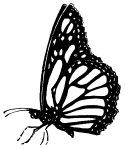 willow, hackberry, butterfly bush, and the various
cherries and oaks provide important food habitat for butterflies and caterpillars.
Coralberry, snowberry, and spicebush are also valuable to moths. Cherries, apples, plums,
peach, pussy willows, lilacs, coralberry, snowberry, and wolfberry are critical sources of
pollen for bees. willow, hackberry, butterfly bush, and the various
cherries and oaks provide important food habitat for butterflies and caterpillars.
Coralberry, snowberry, and spicebush are also valuable to moths. Cherries, apples, plums,
peach, pussy willows, lilacs, coralberry, snowberry, and wolfberry are critical sources of
pollen for bees.
Plantings that provide food in summer help juvenile birds as well as early migrants to
develop early winter energy reserves. Wild plum, serviceberry, red elder, hazelnut,
mulberry, and the cherry species (choke, nanking, and pin) all provide important
late-summer foods. The dogwoods (red-osier, silky, and gray), winterberry, American
mountain-ash, hawthorn, crabapple, nannyberry, bearberry, buffaloberry, and arrowwood are
all shrubs that provide valuable fall fruits. Nut-producing trees such as oak, hickory,
butternut, and black walnut are also key fall foods for both migratory and resident
wildlife.
Shrubs and trees must have persistent fruits in order to have winter value. The better
ones are not palatable earlier in the year nor are highly preferred. Winter thaws and cold
weather may make them more desirable to wildlife later in the
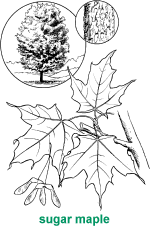 year. Black chokecherry, crabapples, snowberry, staghorn sumac, hawthorn, American
mountain-ash, nannyberry, and American highbush cranberry all have persistent winter
fruits. Maple, ash, white pine, and white cedar are important sources of winter browse for deer and rabbits.
year. Black chokecherry, crabapples, snowberry, staghorn sumac, hawthorn, American
mountain-ash, nannyberry, and American highbush cranberry all have persistent winter
fruits. Maple, ash, white pine, and white cedar are important sources of winter browse for deer and rabbits.
Many of these species provide cover for wildlife. Conifers are important sources of
thermal and nesting cover for many species of wildlife, especially songbirds. Red and
white cedar, hemlock, balsam fir, and the many kinds of spruce provide crucial winter
cover because of their dense boughs. All trees and shrubs can provide nesting cover for
some type of songbird, but plants that offer high quality nesting cover include hawthorns,
cedars, crabapples, hemlocks, dogwoods, and spruces. Cavity-producing trees such as older
beech and white oak provide homes for squirrels,
screech owls, wood ducks, and many songbirds including chickadees. Therefore, dead and
dying trees (snags) should be kept, if
possible.
The following shrubs and shrub families should be highly considered as they are well
adapted to Michigan's soil and climate conditions and offer valuable year-round wildlife
habitat components:
American Highbush Cranberry is a widely available viburnum that is an upright,
tall (8 to 12 feet) shrub adaptable to most soil types. It fruits well on sunny sites and
its bright red berries remain on the bush well into winter. It is used for nesting by
brown thrashers, catbirds, and many other songbirds. An excellent wildlife shrub on moist
sites, it will also grow on sandy soil, although more slowly.
Dogwoods are used intensively by wildlife. In Michigan, the most popular
varieties include silky dogwood, gray dogwood, and red-osier dogwood. They all produce
flowers in the spring and fruits in the fall, and adapt to a variety of soils. Red-osier
dogwood is so named as its bark is a bright to deep red when in full sun areas. It thrives
on moist areas as well as sandy sites and can easily be used to form dense hedges.
Elderberry is often overlooked as a shrub for wildlife. Growing on a variety of
sites in both sun and shade, it fruits best in sunny, moist areas to attract many songbird
species in late summer and fall. Black elderberry is found on lowland sites, while red
elderberry is found on upland sites.
Junipers and cedars provide good cover, nest sites, and food for songbirds.
Scattered among deciduous shrubs, they enhance habitat diversity and can be used effectively
in windbreaks and other strip covers. One drawback is that eastern red cedar is the
alternate host for cedar-apple rust, which results in blemishes on the fruit and leaves of
apple, crabapple, and hawthorns. For this reason do not plant it close to apple orchards.
Hawthorns are small thornapple trees that bear persistent fruits and are
excellent nesting sites for songbirds. Washington Hawthorn is a common variety. Although
difficult to transplant, hawthorns survive well on upland and lowland sites. They do best
when planted at regular, well-spaced intervals among other low-growing trees and shrubs.
Crabapples come in many varieties from nurseries and grow from 10 to 30 feet
tall. Like hawthorns, they provide nest sites for robins and other songbirds. They also
have stunning flowers in the spring and fruits in the fall that are persistent through
winter. If possible, choose disease resistant varieties.
Wild plums are growing in popularity among wildlife biologists as an alternative
to planting exotic species.
They have showy flowers and produce fruits that humans may also use. They spread by suckers to form clumps.
Nannyberry is a tall shrub or small tree that is used as an ornamental for its
attractive flowers. It provides fruits in the fall for many species of wildlife. This
shrub spreads by suckers and may be difficult to control near lawns and gardens.
See the accompanying panel for popular species of conifer and deciduous trees to
consider planting in your backyard.
Aesthetic Characteristics
When choosing trees and shrubs for your property, considering their characteristics
such as color, texture, and height, which will help you to provide a pleasing landscape.
Early blossoming shrubs such as crabapples, lilacs, serviceberry, and redbuds offer spring
color. Silky dogwood and red elder give summer color, and red elder, sumac, and red-osier
dogwood provide a palette of beauty in late summer and early fall. Fall-fruiting shrubs
and the leaves of maple, birch, aspen, and other deciduous trees furnish an array of color
in fall. Red-osier dogwoods show a striking red, and conifers give a pleasing green to a
bleak winter landscape.
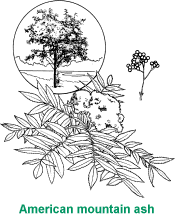 Pyramid-shaped American mountain-ash, tamarack, and spruces,
round-shaped crabapples and dogwoods, and flat junipers all add different shapes and forms
to your property. The fine textures of hemlock, white pine, and serviceberry can be a
sharp contrast to rough-textured plants such as hawthorn and jack pine. Pyramid-shaped American mountain-ash, tamarack, and spruces,
round-shaped crabapples and dogwoods, and flat junipers all add different shapes and forms
to your property. The fine textures of hemlock, white pine, and serviceberry can be a
sharp contrast to rough-textured plants such as hawthorn and jack pine.
Trees and shrubs come in many heights. Choosing a variety of heights assures nesting
and feeding sites for birds with strong preferences for specific elevations. It also
provides visual screens and adds to landscape diversity. To develop a
"feathering" or "staircase" effect, which is highly beneficial for
wildlife, plant oaks, hickories, and tall conifers at property borders. As you move closer
to your home, add serviceberry, American mountain-ash, and medium-height shrubs such as
dogwoods and crabapples. Low-growing shrubs such as bearberry and coralberry, will
complete the staircase effect to your lawn. Beyond this, you may want to plant grasses or
wildflowers to further increase your yard’s value to wildlife.
Landscape Characteristics
Another important factor to consider before selecting trees and shrubs is the
characteristics of your property, which may include soil types and locations of your
plantings. Before planting, it's a good idea to determine the pH and available nutrients in your soil. For example,
you should not plant a shrub that is needs moist, acidic soils on a dry, sandy site. Even
though the shrub may fit all of your landscape goals (color, texture, wildlife value), it
may not fit in with your landscape characteristics. Therefore, it will most likely not
grow on your property and you will have wasted your time and money. For a nominal fee your
county's Michigan State University Extension office will analyze soil samples from your
yard. Refer to the chapter Knowing Your
Soil in the Habitat Planning section for more
information.
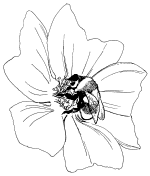 Another thing to consider is the location of your planting. You
may not want a nut producing tree in an area where the nuts will be a problem, such as
near a pool. Another example of location problems is seen with mulberry trees. These trees
should be planted along property boundaries and away from porches, decks, and cars because
its fruit and droppings from birds eating mulberries will stain. Another thing to consider is the location of your planting. You
may not want a nut producing tree in an area where the nuts will be a problem, such as
near a pool. Another example of location problems is seen with mulberry trees. These trees
should be planted along property boundaries and away from porches, decks, and cars because
its fruit and droppings from birds eating mulberries will stain.
Another thing to remember with location is the height that the trees and shrubs will
grow. Be careful that they will not grow too tall and encroach on other backyard projects.
For instance, a tree is planted in a spot where it is not currently shading a garden.
However, if the height of the tree is not checked, in a few years it may cast a much
larger shadow than expected. Therefore, be sure to plant the trees and shrubs far enough
from each other and any other areas where they may cause problems.
In summary, there are many trees and shrubs that can not only create valuable habitat
for wildlife, but also enhance the value of your home. When selecting trees and shrubs for
your yard, it is important to consider your landscaping goals, the wildlife values and
aesthetic characteristics of the plants, and the characteristics of the current landscape.
With these in mind you will create a beautiful landscape that will also benefit wildlife.
Refer to the chapter Tree & Shrub Planting in this section for more information.
For more information available on the World Wide Web about "Trees &
Shrubs," please see our Resource Links.
Last Revised: May 5, 2000
|

